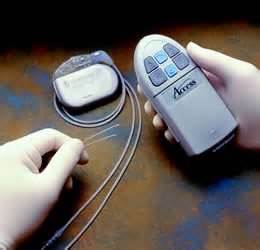 Researchers at the Mayo Clinic have found a way to monitor real-time changes in neurotransmitters in the brain with the use of deep brain stimulation (DBS. The breaking insight will help physicians more effectively use DBS to treat brain disorder like Parkinson's disease,Tourette syndrome and depressions.
Researchers at the Mayo Clinic have found a way to monitor real-time changes in neurotransmitters in the brain with the use of deep brain stimulation (DBS. The breaking insight will help physicians more effectively use DBS to treat brain disorder like Parkinson's disease,Tourette syndrome and depressions.The findings have been published in the journal Mayo Clinic Proceedings
Researchers hope to use the new discovery to create a DBS system that can respond instantly to chemical changes in the brain. Tourette syndrome, Parkinson's and depression are caused by either an excess or a deficency of neurochemicals within the brain. The idea is to monitor and adjust the neurotransmitters to appropriate levels.
"We can learn what neurochemicals can be released by DBS, neurochemical stimulation, or other stimulation. We can basically learn how the brain works," says author Su-Youne Chang, Ph.D., of the Mayo Clinic Neurosurgery Department.
researchers where able to observe the changes of the neurotransmitter adenosine in the brains of tremor patients who where undergoing DBS. Neurotrasmitters are chemicals that transmit signals from cell to cell across a synapse.
 Using fast scan cyclic voltammetry or FSCV they were able to quantify concentrations of adenosine released during deep brain stimulation. The data was recorded using Wireless Instantaneous Neurotransmitter Concentration Sensing, a small wireless neurochemical sensor implanted in the patient's brain. The sensor, combined with FSCV, scans for the neurotransmitter and translates that information onto a laptop in the operating room. The sensor has previously identified neurotransmitters serotonin and dopamine in tests in brain tissue. This was the first time researchers used this technique in patients.
Using fast scan cyclic voltammetry or FSCV they were able to quantify concentrations of adenosine released during deep brain stimulation. The data was recorded using Wireless Instantaneous Neurotransmitter Concentration Sensing, a small wireless neurochemical sensor implanted in the patient's brain. The sensor, combined with FSCV, scans for the neurotransmitter and translates that information onto a laptop in the operating room. The sensor has previously identified neurotransmitters serotonin and dopamine in tests in brain tissue. This was the first time researchers used this technique in patients.Tremors are a visual cue that the technique is working; researchers suspect adenosine plays a role in reducing tremors.
Researchers also hope to learn more about conditions without such external manifestations.
"We can't watch pain as we do tremors," says Kendall Lee, M.D., Ph.D., a Mayo Clinic neurosurgeon. "What is exciting about this electrochemical feedback is that we can monitor the brain without external feedback. So now, we can monitor neurochemicals in the brain and learn about brain processes like pain."
DBS has been used successfully worldwide to treat patients with tremors. However, physicians do not fully understand why DBS works in patients. They know that when DBS electrodes are inserted before electrical stimulation, there is an immediate tremor reduction. Known as the microthalamotomy effect, it is reported in up to 53 percent of patients and known to last as long as a year.
Researchers hope to use the study findings to create a self-contained "smart" DBS system.
 "With the stimulator and detection, we can create algorithms and then raise neurotransmitters to a specified level," says Kevin Bennet, a Mayo Clinic engineer who helped create the system. "We can raise these chemicals to appropriate levels, rising and falling with each person throughout their life. Within milliseconds, we can measure, calculate and respond. From the patient's perspective, this would be essentially instantaneous."
"With the stimulator and detection, we can create algorithms and then raise neurotransmitters to a specified level," says Kevin Bennet, a Mayo Clinic engineer who helped create the system. "We can raise these chemicals to appropriate levels, rising and falling with each person throughout their life. Within milliseconds, we can measure, calculate and respond. From the patient's perspective, this would be essentially instantaneous."The work was supported in part by the National Institutes of Health and the Grainger Foundation.
Grow Cannabis Indoors


My partner and I stumbled over here different website
ReplyDeleteand thought I might as well check things out. I like what I see so now i'm following you. Look forward to finding out about your web page repeatedly.
Also visit my blog; 5 htp